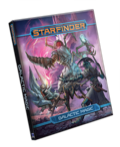Sign in to create or edit a product review. This is an entertaining read, especially to those familiar with the setting. (I think it would be a fun read to those not familiar with the setting too. But parts of it might be hard to follow without some prior familiarity.) The book also includes some interesting additions to the Starfinder lore. It includes a detailed description of the motivations behind the founding of the Hellknight Order of the Eclipse and the Starfinder Society. And it has lots of interesting new details regarding the Gap. To set expectations: it doesn't provide direct answers to the biggest questions - what caused the Gap, where the planet Golarion went, how long the Gap lasted, etc. But it does provide a number of new details around the periphery. It describes what happened on Absalom Station right after the Gap, and its impact on society. And it includes some interesting tidbits about the big mysteries (e.g., that not all of the Gods were on board with keeping what the Gap covered up a secret, and that there's a way to find that answers to some of the big questions about the Gap). But the part I found the most interesting was that it describes what it was like for the people waking up after the Gap. There are a lot of intriguing details here, but roughly: (1) What people remember is variable. Pretty much everyone remembers their name. Many people remember their important relationships (e.g., that they're married to someone named "Starla", and that Starla is the person they woke up next to). Some remember a little about what they were doing (e.g., that they're looking after a bar for my a friend called "Bric"). And some people remember (or come to remember after interacting with them) that some items of personal significance were theirs (e.g., that this is my trusty pair of pistols). But what people remember varies a lot from person to person. (2) Although people remember some factual information, they don't have any phenomenal memories of what happened during the Gap. I.e., someone might remember that they were looking after a house for a friend, and that this friend's name was "Sue", and that Sue is away on an expedition. But they won't have any memories of meeting or interacting with Sue. Likewise, people generally remember everyday information (e.g., that they're on Absalom Station, what the different species are, and what they're like, how technology works, etc), but will have no memories of how they came to know these things. Definitely worth reading for fans of the Starfinder setting. But don't expect the book to spill the beans on the cause of the Gap. 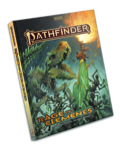
Pathfinder Rage of ElementsPaizo Inc.Add Print Edition $54.99 Add PDF $19.99
Add
Non-Mint
A great book for crunch and loreThe kineticist is amazing - for my money, the most interesting and fun class Paizo has produced to date. The rest of the book adds a lot of interesting mechanical options as well - a number of interesting spells, some cool subclass options, some interesting items, and the like. It also includes stat blocks for a number of elemental creatures. Lore-wise, there's an interesting revision to the old-school D&D picture of the elemental planes, which is welcome. And the description of the planes is fun, and sprinkles in a some plot hooks and interesting locations, which I *love*. Constructive criticism-wise: I would have loved to have even more on the elemental lore; I'd happily trade the bestiary stat blocks and items sections for more of that. For example, I'd love to have a better feel for how we're supposed to think about the "nested shells" picture of the planes they present. (If the planes are infinite, as some of the text suggests, how can they be nested shells? Should we think of them as analogous to slabs with finite thickness but infinite extension? So you could both travel a finite distance to get through one plane to the next, and yet also travel forever within a plane if you traveled in the right direction? And how should we think about the "center" of a plane, which some other text refers to? Or should we think of this as something like the "spiritual" center of the plane, rather than the physical center?) I'd also have loved to get even more plot hooks and discussions of interesting locations/weird features of the elemental planes. And while the crunch stuff is mostly first-rate, the revised elementalist archetype still seems like a big step down in power for little payoff. But this is a relatively minor issue in a fantastic book. 
Pathfinder Adventure Path #185: A Taste of Ashes (Blood Lords 5 of 6)Paizo Inc.Add Print Edition $26.99 Add PDF $19.99 Non-Mint Unavailable A fun exploration of another central city in GebTHE GOOD:
THE BAD:
THE UGLY/PRETTY:
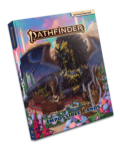
Pathfinder Lost Omens: Impossible LandsPaizo Inc.Add Print Edition $59.99 Add PDF $29.99 Non-Mint Unavailable Another Fantastic Addition to the Lost Omens LineThis book is fantastic. It introduces a number of great ancestries, with enough page count to make them rich and exciting options. It describes a number of fantastic adventuring locations with a radically different feel from anything else you'll find in the Inner Sea. It's great at offering inspiration for adventuring ideas; each of the three cities in Nex made me want to run a campaign based in that city. And the art - I'm not a big art person in general, but the art in this book is AMAZING. Probably the most evocative, imagination-inspiring, and beautiful art I've seen in any Paizo book. (And that's a high bar!) This book is neck-in-neck with the (phenomenal) Mwangi Expanse book for my favorite book in the Lost Omens line. 
Pathfinder Adventure Path #184: The Ghouls Hunger (Blood Lords 4 of 6)Paizo Inc.Add Print Edition $26.99 Add PDF $19.99 Non-Mint Unavailable Raising the stakes with some epic NPCsThe Good:
The Bad:
The Ugly/Pretty:

Pathfinder Adventure Path #183: Field of Maidens (Blood Lords 3 of 6)Paizo Inc.Add Print Edition $26.99 Add PDF $19.99 Non-Mint Unavailable A somewhat fragmented third bookI really liked the first two books of this AP, but this book was a little disappointing. It has some nice parts, but the plot tying it together felt a little shaky. The Good:
The Bad:
Spoiler:
(They demand that the PCs give them all of the magical items the party collects from a random place because they think that these items might be relevant to their project. But there doesn’t seem to be any reason to think that anything from this location would help with the antagonist’s project, or any reason why standard and clearly irrelevant equipment would be something they would think might help them with this project.) —Much of the book after the first chapter seems fairly generic content that you could more or less transport into any AP. This is a shame, and misses out on highlighting the weirdness and coolness of adventuring in such an exotic locale. The Ugly/Pretty:
Overall: 3.25/5 Stars 
Pathfinder Adventure Path #182: Graveclaw (Blood Lords 2 of 6)Paizo Inc.Add Print Edition $26.99 Add PDF $19.99 Another fun leg in a horror-focused APThe Good:
The Bad:
The Ugly/Pretty:
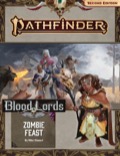
Pathfinder Adventure Path #181: Zombie Feast (Blood Lords 1 of 6)Paizo Inc.Add Print Edition $26.99 Add PDF $19.99 Non-Mint Unavailable A creepy module that encourages smart playThe good:
The bad:
The ugly/pretty:
Overall, a great start to a creepy AP! 
Pathfinder Adventure Path #179: Cradle of Quartz (Outlaws of Alkenstar 2 of 3)Paizo Inc.Add Print Edition $24.99 Add PDF $19.99 Non-Mint Unavailable Good Raw Materials With Weird ExecutionLet me start by being clear - as with all of Paizo's stuff, this is a high-quality book. The book is beautiful, the art is high-quality, and so on. That said, there are a frustrating number of strange mistakes and errors/omissions that made it into the final version of this book. A microcosm of this is the chapter in which the party boards and faces adventure on a flying clockwork ship. (Spoilers ahead.) A great set-up! But then there are weird plot-points. Before the party can board the ship, they have to jump through hoops to convince a number of other people to also make the voyage. Why can't they just pay for the extra seats themselves? Well, we're told, the captain's ego requires that more people sign up(?!). And why can't they just hire some assistants to travel with them and pay for their seats?... Um... it's not clear. Likewise, there seem to be mistakes in the set-up of the ship itself. It looks like there's a large stairwell that goes to the first-mate's room, and nowhere else. And that this is the only way in and out of the first-mate's room. Even though this room is right next to all of the others, and could be conveniently reached if there was a door to the main hallway, as there is with all the other rooms. Likewise, there's a room with ballistas that plays an important role in one of the encounters... except the room is completely omitted from the description of the ship. Anyway, with some patching up and a little work on the GM's side, there's a serviceable adventure here. But this requires more work of this type than one would like. 
Pathfinder Adventure Path #180: The Smoking Gun (Outlaws of Alkenstar 3 of 3)Paizo Inc.Add Print Edition $24.99 Add PDF $19.99 Non-Mint Unavailable Going Out With A BangThis is a fun conclusion to the AP, and (in my view) the strongest book in the series. This book displays all of the usual Paizo strengths - beautiful art and maps, interesting NPCs, some cool new monsters. But this book also does a couple things particularly well. First, it has some really cinematic and kick-ass scenes. Big, dramatic, block-buster feeling scenarios, like fighting above a giant cannon, trying desperately to fight off a horde of enemies swarming over the horizon. Second, it does a nice job of providing lots of ways to get around encounters besides fighting through them, and in fights keeps a good mind to alternate "win" conditions - enemies who will surrender, or flee, or what have you, at a certain point. Third, more than any other AP book to date, it sets up interesting combats - combats which build in the staggered arrival of enemies, combats with moving components, combats with battlefield effects that can really change the feel of the combat. Really fantastic work here. Well done! 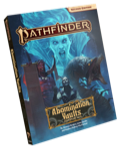
Pathfinder Adventure Path: Abomination VaultsPaizo Inc.Add Print Edition $54.99 Add PDF $38.99 Non-Mint Unavailable A MasterpieceDungeon-crawls aren’t really my thing. But this is the best dungeon-crawl style adventure I’ve seen. It has an overarching plot driving the exploration, giving the adventurers a sense of purpose and urgency. It’s filled with sub-quests tied to the different factions in dungeon and to the people in the nearby town. It presents a number of entertaining NPCs and role-playing possibilities for the players to take advantage of. (Make sure the party has someone who can speak Undercommon and Aklo!) And it weaves in some mystery-solving, with a scattering of clues about the dungeon’s history (and about the main plot) well-distributed throughout. It does a nice job of explicitly presenting the dungeon in a dynamic way, describing some of the likely movements of various occupants of the dungeon over time. It introduces “Environmental Cues” to the sidebar descriptions of each level, providing some nice aesthetic guidance for the GM to elaborate on. And unlike the early PF2 APs, it’s pitched at a more reasonable difficulty level. But the most impressive feature of this dungeon is how organic and well put-together it is. Each room has a history, a reason for why it’s there. The occupants of each room make sense, and tie into the history, and the other occupants of the dungeon, in natural and organic ways. The levels are nicely integrated with each other. It all just makes sense. I tend to dislike dungeon-crawl-style adventures because they often seem to consist of a bunch of random rooms, filled with random monsters; and if you’re lucky, the monsters on a level might be thematically related to each other, although the levels themselves rarely are. This adventure is the exact opposite of that. And even though dungeon-crawls aren’t my thing, it’s hard to deny that this one is a masterpiece. 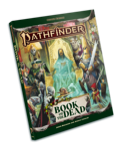
Pathfinder Book of the DeadPaizo Inc.Add Print Edition $49.99 Add PDF $19.99
Add
Non-Mint
A lore-packed book full of undead-centered options
Pathfinder Adventure Path #177: Burning Tundra (Quest for the Frozen Flame 3 of 3)Paizo Inc.Add Print Edition $24.99 Add PDF $19.99 Non-Mint Unavailable An epic and atmospheric conclusion to the hexploration AP
Pathfinder Adventure Path #176: Lost Mammoth Valley (Quest for the Frozen Flame 2 of 3)Paizo Inc.Add Print Edition $24.99 Add PDF $19.99 Non-Mint Unavailable A solid follow-up to the hexploration AP, marred by a few plot holes
Pathfinder Adventure Path #175: Broken Tusk Moon (Quest for the Frozen Flame 1 of 3)Paizo Inc.Add Print Edition $24.99 Add PDF $19.99 A great intro to a hexploration-based APThe Good:
The Bad:
The Pretty:

Pathfinder Adventure Path #173: Doorway to the Red Star (Strength of Thousands 5 of 6)Paizo Inc.Print Edition Unavailable Add PDF $19.99 Non-Mint Unavailable An Amazing AP for RP-focused groups(This is a holistic review that’s been written for the AP as a whole, excepting the 6th book which has been delayed for shipping delays.) Although I love Paizo APs, there are certain features of them that have always felt a bit awkward . 1. Most APs will bring the PCs from level 1-20 in a matter of months. It’s hard to square this with typical fictional narratives, where one becomes a mighty wizard, or the world’s best swordsman, over decades of study and experience. 2. When it gets to higher level play, many APs at least partially fail to appropriately justify the higher-level challenges that the PCs face in a way that feels appropriately epic. (For one of the most glaring examples of this, the last book of Age of Ashes has the PCs dealing with level 19(!) city guards.) 3. And pretty much every AP is written with the implicit assumption that the PCs will resolve most encounters violently, with enemies fighting to the death, and the PCs expected to wrack up an impressive body count along the way. In light of all of this, the Strength of Thousands AP feels like a breath of fresh air. Advancement takes place at a narratively satisfying rate. Years can pass between levels, and the players are doing things in the meantime that lend themselves to the fiction of advancement and improving their knowledge and magical abilities. The higher level books really “amp up” as the party gains levels. The first book *feels* like a book with challenges for students, the second and third books feel like books with challenges for competent teachers, and the fourth and fifth books are appropriately epic — books four and five have the PCs doing more epic things than many book six adventures of other APs. And the book assumes and incentivizes peaceful resolutions to a much broader range of encounters than any previous AP I can think of. And when violence is likely to occur, the books generally incentivize non-lethal approaches to dealing with enemies. Add to that a sea of interesting and detailed NPCs for the PCs to engage with, and this is a perfect AP for role-play focused groups, and groups that really enjoy digging into the downtime aspects of the game, and building lives for their characters that stretch beyond their martial prowess. The Mwangi Expanse was one of Paizo's best lore books. I’m grateful to see that it's been paired with one of Paizo’s best APs! 
Pathfinder Adventure Path #172: Secrets of the Temple-City (Strength of Thousands 4 of 6)Paizo Inc.Print Edition Unavailable Add PDF $19.99 Non-Mint Unavailable An Amazing AP for RP-focused groups(This is a holistic review that’s been written for the AP as a whole, excepting the 6th book which has been delayed for shipping delays.) Although I love Paizo APs, there are certain features of them that have always felt a bit awkward . 1. Most APs will bring the PCs from level 1-20 in a matter of months. It’s hard to square this with typical fictional narratives, where one becomes a mighty wizard, or the world’s best swordsman, over decades of study and experience. 2. When it gets to higher level play, many APs at least partially fail to appropriately justify the higher-level challenges that the PCs face in a way that feels appropriately epic. (For one of the most glaring examples of this, the last book of Age of Ashes has the PCs dealing with level 19(!) city guards.) 3. And pretty much every AP is written with the implicit assumption that the PCs will resolve most encounters violently, with enemies fighting to the death, and the PCs expected to wrack up an impressive body count along the way. In light of all of this, the Strength of Thousands AP feels like a breath of fresh air. Advancement takes place at a narratively satisfying rate. Years can pass between levels, and the players are doing things in the meantime that lend themselves to the fiction of advancement and improving their knowledge and magical abilities. The higher level books really “amp up” as the party gains levels. The first book *feels* like a book with challenges for students, the second and third books feel like books with challenges for competent teachers, and the fourth and fifth books are appropriately epic — books four and five have the PCs doing more epic things than many book six adventures of other APs. And the book assumes and incentivizes peaceful resolutions to a much broader range of encounters than any previous AP I can think of. And when violence is likely to occur, the books generally incentivize non-lethal approaches to dealing with enemies. Add to that a sea of interesting and detailed NPCs for the PCs to engage with, and this is a perfect AP for role-play focused groups, and groups that really enjoy digging into the downtime aspects of the game, and building lives for their characters that stretch beyond their martial prowess. The Mwangi Expanse was one of Paizo's best lore books. I’m grateful to see that it's been paired with one of Paizo’s best APs! 
Pathfinder Adventure Path #171: Hurricane's Howl (Strength of Thousands 3 of 6)Paizo Inc.Print Edition Unavailable Add PDF $19.99 Non-Mint Unavailable An Amazing AP for RP-focused groups(This is a holistic review that’s been written for the AP as a whole, excepting the 6th book which has been delayed for shipping delays.) Although I love Paizo APs, there are certain features of them that have always felt a bit awkward . 1. Most APs will bring the PCs from level 1-20 in a matter of months. It’s hard to square this with typical fictional narratives, where one becomes a mighty wizard, or the world’s best swordsman, over decades of study and experience. 2. When it gets to higher level play, many APs at least partially fail to appropriately justify the higher-level challenges that the PCs face in a way that feels appropriately epic. (For one of the most glaring examples of this, the last book of Age of Ashes has the PCs dealing with level 19(!) city guards.) 3. And pretty much every AP is written with the implicit assumption that the PCs will resolve most encounters violently, with enemies fighting to the death, and the PCs expected to wrack up an impressive body count along the way. In light of all of this, the Strength of Thousands AP feels like a breath of fresh air. Advancement takes place at a narratively satisfying rate. Years can pass between levels, and the players are doing things in the meantime that lend themselves to the fiction of advancement and improving their knowledge and magical abilities. The higher level books really “amp up” as the party gains levels. The first book *feels* like a book with challenges for students, the second and third books feel like books with challenges for competent teachers, and the fourth and fifth books are appropriately epic — books four and five have the PCs doing more epic things than many book six adventures of other APs. And the book assumes and incentivizes peaceful resolutions to a much broader range of encounters than any previous AP I can think of. And when violence is likely to occur, the books generally incentivize non-lethal approaches to dealing with enemies. Add to that a sea of interesting and detailed NPCs for the PCs to engage with, and this is a perfect AP for role-play focused groups, and groups that really enjoy digging into the downtime aspects of the game, and building lives for their characters that stretch beyond their martial prowess. The Mwangi Expanse was one of Paizo's best lore books. I’m grateful to see that it's been paired with one of Paizo’s best APs! 
Pathfinder Adventure Path #170: Spoken on the Song Wind (Strength of Thousands 2 of 6)Paizo Inc.Add Print Edition $24.99 Add Download $19.99 Non-Mint Unavailable An Amazing AP for RP-focused groups(This is a holistic review that’s been written for the AP as a whole, excepting the 6th book which has been delayed for shipping delays.) Although I love Paizo APs, there are certain features of them that have always felt a bit awkward . 1. Most APs will bring the PCs from level 1-20 in a matter of months. It’s hard to square this with typical fictional narratives, where one becomes a mighty wizard, or the world’s best swordsman, over decades of study and experience. 2. When it gets to higher level play, many APs at least partially fail to appropriately justify the higher-level challenges that the PCs face in a way that feels appropriately epic. (For one of the most glaring examples of this, the last book of Age of Ashes has the PCs dealing with level 19(!) city guards.) 3. And pretty much every AP is written with the implicit assumption that the PCs will resolve most encounters violently, with enemies fighting to the death, and the PCs expected to wrack up an impressive body count along the way. In light of all of this, the Strength of Thousands AP feels like a breath of fresh air. Advancement takes place at a narratively satisfying rate. Years can pass between levels, and the players are doing things in the meantime that lend themselves to the fiction of advancement and improving their knowledge and magical abilities. The higher level books really “amp up” as the party gains levels. The first book *feels* like a book with challenges for students, the second and third books feel like books with challenges for competent teachers, and the fourth and fifth books are appropriately epic — books four and five have the PCs doing more epic things than many book six adventures of other APs. And the book assumes and incentivizes peaceful resolutions to a much broader range of encounters than any previous AP I can think of. And when violence is likely to occur, the books generally incentivize non-lethal approaches to dealing with enemies. Add to that a sea of interesting and detailed NPCs for the PCs to engage with, and this is a perfect AP for role-play focused groups, and groups that really enjoy digging into the downtime aspects of the game, and building lives for their characters that stretch beyond their martial prowess. The Mwangi Expanse was one of Paizo's best lore books. I’m grateful to see that it's been paired with one of Paizo’s best APs! 
Pathfinder Adventure Path #169: Kindled Magic (Strength of Thousands 1 of 6)Paizo Inc.Add Print Edition $24.99 Add PDF $19.99 Non-Mint Unavailable An Amazing AP for RP-focused groups(This is a holistic review that’s been written for the AP as a whole, excepting the 6th book which has been delayed for shipping delays.) Although I love Paizo APs, there are certain features of them that have always felt a bit awkward . 1. Most APs will bring the PCs from level 1-20 in a matter of months. It’s hard to square this with typical fictional narratives, where one becomes a mighty wizard, or the world’s best swordsman, over decades of study and experience. 2. When it gets to higher level play, many APs at least partially fail to appropriately justify the higher-level challenges that the PCs face in a way that feels appropriately epic. (For one of the most glaring examples of this, the last book of Age of Ashes has the PCs dealing with level 19(!) city guards.) 3. And pretty much every AP is written with the implicit assumption that the PCs will resolve most encounters violently, with enemies fighting to the death, and the PCs expected to wrack up an impressive body count along the way. In light of all of this, the Strength of Thousands AP feels like a breath of fresh air. Advancement takes place at a narratively satisfying rate. Years can pass between levels, and the players are doing things in the meantime that lend themselves to the fiction of advancement and improving their knowledge and magical abilities. The higher level books really “amp up” as the party gains levels. The first book *feels* like a book with challenges for students, the second and third books feel like books with challenges for competent teachers, and the fourth and fifth books are appropriately epic — books four and five have the PCs doing more epic things than many book six adventures of other APs. And the book assumes and incentivizes peaceful resolutions to a much broader range of encounters than any previous AP I can think of. And when violence is likely to occur, the books generally incentivize non-lethal approaches to dealing with enemies. Add to that a sea of interesting and detailed NPCs for the PCs to engage with, and this is a perfect AP for role-play focused groups, and groups that really enjoy digging into the downtime aspects of the game, and building lives for their characters that stretch beyond their martial prowess. The Mwangi Expanse was one of Paizo's best lore books. I’m happy to see that it's been paired with one of Paizo’s best APs! 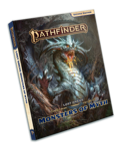
Pathfinder Lost Omens: Monsters of MythPaizo Inc.Add Print Edition $34.99 Add PDF $29.99 Non-Mint Unavailable The best “short” Lost Omens book to dateI wasn’t very excited about this book. I thought it would probably be a mini-bestiary. Or, if we were lucky, something along the lines of the “monsters revisited” line, which are pretty great, but largely because they provide new angles to approach old classic monsters. What I didn’t expect was 20 sketches for home-brew APs. And that’s basically what this book is. Each monster is given some rich informative lore, brimming with potential adventure ideas, a juicy stat block, some epic items or player options that tie into the creature’s lore, and a sketch regarding the different kinds of adventuring opportunities the monster presents, for low-level, mid-level, and high-level campaigns. Each entry left me swimming with ideas, and wanting to run a home-brew campaign centered around the monster. A really amazing book. My favorite “short” Lost Omens book to date. 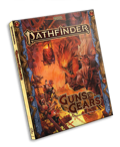
Pathfinder Guns & GearsPaizo Inc.Add Print Edition $49.99 Add PDF $19.99
Add
Non-Mint
Steampunk Arrives!This books makes a great addition to the PF2 rulebooks, setting up GMs and players who want to bring an element of steampunk and gun-fantasy into their games. Mechanically, there's a lot to like here. There are two new, well-balanced classes, the Inventor and Gunslinger, and several interesting archetypes. There are rules for a lot of new mundane equipment, with rules for new martial and advanced crossbows and firearms taking center-stage. As one would expect, these are immaculately well-balanced, providing interesting options, but nothing that overtakes, power-wise, pre-existing options. There are also a bevy of new combination weapons — melee and ranged weapons combined — though these seem a little underwhelming compared to existing options. Finally, there are lots of firearm accessories and magical firearms, which add interesting dimensions to play. And, my favorite new addition: stasian tech and clockwork gadgets! These are great additions to the game, both with respect to mechanical options, and flavor-wise. I hope we’ll see more of these in the future. There are also rules for a number of more niche facets of the game that you can ignore if they don't come up, but are immensely helpful to have on hand if they do: rules for Siege Weapons and Vehicles. Both will see their role in the appropriate kind of campaign. There’s also a lot of lore in this book, with about a quarter of this book being devoted to the role of firearms and technological advances in various places in Golarion, including some lore on Arcadia! I found some of this lore more enjoyable than others, but most of it’s very good, my favorite parts being those that shower GMs with plot-hooks, like the excellent section on Ustalav. All-in-all, a great addition to PF2. Here’s hoping we’ll get more books like this in the future! 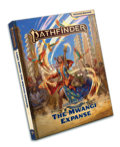
Pathfinder Lost Omens: The Mwangi ExpansePaizo Inc.Add Print Edition $49.99 Add PDF $29.99 Non-Mint Unavailable An amazing book filled with juicy plot hooks and adventure localesThis is an amazing and hefty (300+ pages) book; as good as any book on RPG lore I've read. There are tons of great things about this book - amazing art, in-depth characterizations of different ancestries, including new zany ancestries like spider people and sentient crystalline orbs embedded in wood-golem-like bodies, a batch of intriguing new deities, a mini-bestiary with a slew of new creatures, and even a handful of local recipes. But my favorite part of this book is the "Geography" section, 140 pages of in-depth descriptions of different parts of the Mwangi expanse. This section is fantastic, and absolutely dripping with juicy plot hooks and adventuring locales. An ancient city with magical spires formed from chunks of ancient buildings magically stacked on top of each other and suspended in the air? A xenophobic city ruled by an undead child who is a sun god (for real - an actual god), whose temperament changes with the position of the sun each day? A secret city build to contain an ancient well that wafts turquoise ether and sinister whispers, which is guarded by an immensely powerful tree that’s watched over it for 10,000 years? Fantastic stuff. 
Pathfinder Adventure Path #165: Eyes of Empty Death (Abomination Vaults 3 of 3)Paizo Inc.Add Print Edition $24.99 Add PDF $19.99
Add
Non-Mint
A fitting conclusion to a masterful dungeon crawlGiven the high bar set by the first two books of this AP, I’ve been anxious about whether the third book would stand up by comparison. As it turns out, I needn’t have worried — the third book is just as well done as the first two, and leads the AP to a fitting conclusion. This book of the AP shares many of the strengths of the first two. It continues the pattern of providing “environmental cues” for each level, feels organic, has gorgeous art and maps, and plenty of appropriately creepy scenes for GMs who like that sort of thing to lean into. But let me highlight some of the particular strengths of this book. For one, this book does a great job of recreating the feel of an old-school open sandbox. For example, it throws in some encounters that the party is clearly supposed to run from or avoid — like a classic sandbox, the party shouldn’t be expecting to be able to kill absolutely everything they run into. And it offers a lot of different routes for the party to pursue — like an old school sandbox, there’s way more content here than one should expect the party to go through — giving the party real choice about what areas to explore and which to bypass. Another particular strength of this book is that it shifts the difficulty level to a more manageable level than the previous APs. There are a lot more “Low” difficulty encounters. There are a lot more encounters with lots of lower level enemies that give spellcasters an opportunity to shine. And the high difficulty encounters are generally paired with foreshadowing, environmental features, or timing which make these encounters more manageable. Finally, this book cranks up the pressure on the PCs a bit, time-wise, and really shines a spotlight on the main antagonist in a way that prevents them from just being an end boss who the party never interacts with until the final fight. (I’ll avoid saying more to keep this review relatively spoiler free.) All in all, an excellent conclusion to a masterful dungeon crawl.
|
|





